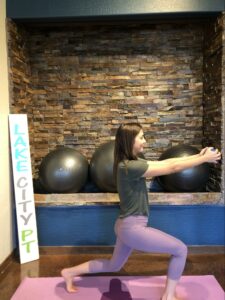
30% of female runners experience a leaky bladder while running. Incontinence is uncomfortable, slows run times and can be embarrassing. There’s is a misconception that being runner fit means having a strong pelvic floor, but this is a misnomer. Running alone doesn’t tone the pelvic floor.
Below we document the three most effective pelvic floor exercises for runners to strengthen the pelvic floor. These exercises create greater neuromuscular control and train the body to form new physical habits.
Comprehensive pelvic floor telehealth sessions from the comfort of your home.
To get a more customized pelvic floor exercises for runners workout plan use our Pelvic Floor Exercises App. The app asked you questions that help us create a customized workout program that will most effectively help you reclaim your pelvic health. Learn more about the app with the button below.
Click here to learn more about Pelvic Floor Pro App
Exercise 1: Jumping Jacks with Pelvic Floor Muscle Engagement
Jumping jacks or star jumps aren’t just an exercise in high school gym class — there also an effective exercise for runners to strengthen the pelvic floor. Jumping jacks combined with pelvic floor muscle engagement help train the body proper muscle engagement during physical movement.
In this exercise, start standing straight and tall with good posture. Next, jump and separate your feet out to each side, whilst raising your arms simultaneously above your head.
As you land with your feet separated and arms raised, actively engage the pelvic floor. When you return to feet together and arms by your side, disengage the pelvic floor.
Perform 10-20 jumping jacks, completing more repetitions as you become better at the exercise.
Exercise 2: Glute Bridging and Pelvic Floor Muscle Engagement

Lay a yoga mat out and lie down facing upward. Ensure your feet flat on the floor and arms are by your side to prepare to execute a glute bridge. As you lift your hips and glutes off the floor, engage the pelvic floor muscle region and the glutes (butt muscles).

Raise your hips high, and then lower and disengage the pelvic floor region – as shown in the image above. This exercise can be increased in difficulty by placing a squishy ball (such as a tennis ball) between your knees. Squeeze the ball with your knees as you raise into a glute bridge. This will further engage your pelvic floor muscles.
This exercise should begin at 10 repetitions, advancing to 20 or more once endurance and strength are built up and dependent on the patients needs.
Exercise 3: Split Squat

From a neutral standing position, take a large step forward with one foot. The back foot should be raised, with only the ball of your foot touching the ground. The front foot should be flat on the ground, pointing straight ahead. Most of your weight should be centered on your front foot.
Ensure that your hips are aligned and facing straight forward. This is very important to train correct alignment and promote the correct running form.
Lower down into the split stance squat, whilst inhaling and engaging your pelvic floor muscles. Your knee should touch the ground. As you begin to rise to a standing position, exhale and mentally cue your Pelvic Floor region to ‘lift’. You should feel like you can engage and disengage your pelvic floor muscle region, a bit like control then release. Be sure to maintain your hips in the forward-facing position and drive power through the glutes and back foot to rise, for good form and correct muscle engagement.
This exercise should be performed in reps of 10-12 each side, dependent on the patients needs and strength levels.
Can running strengthen the pelvic floor?

Running is a high impact sport that puts a lot of stress through the body with each stride. It is therefore very important to have strong muscles, including the pelvic floor muscle group, to support the amount of running you do and take recovery days to repair the body and build strength.
Running can have a negative impact on the pelvic floor, as with each stride, the shock that travels up through the legs and into the pelvis can stress and impact a weak pelvic floor. This explains why many runners suffer from incontinence (urine leakage) when they engage in running.
The solution to prevent this from occurring is to regularly do pelvic floor exercises specific to running. It is about engaging and training the inner deep-abdominal muscle group to work optimally for you when you run. Sadly, this muscle group can’t be trained with simple ab or ‘core’ exercises in the gym. It is important to execute these specific pelvic floor exercises for runners on a regular basis.
3 Myths About The Pelvic Floor – Download Our FREE Ebook Now

Free – Ebooks and Facebook Group
Is running bad for pelvic floor muscles?
Regular running is in fact one of the risk factors that leads to pelvic floor damage, this is because when running our entire body takes the impact for a prolonged period of time. Every single stride puts pressure on the pelvic area, and the muscles of the pelvic floor are in charge of cushioning and protecting it.
A weak pelvic floor can cause leakage of urine and this is very common in women, especially those who’ve had a baby, whether they run or not. Hormonal changes around menopause can make this worse.
Will running make my prolapse worse?
Running with a prolapse can weaken pelvic floor muscles and tissues potentially making prolapse worse.
This puts extra strain on ligaments that hold these organs in place in the body. Ultimately, if these ligaments become too strained, it can lead to a condition called prolapse — where part of the bladder, uterus or bowel protrude into the vagina.
The trouble with running when you have a weak pelvic floor is that over time, the impact can lead the weakened pelvic floor muscles to become progressively more stretched and weakened.

